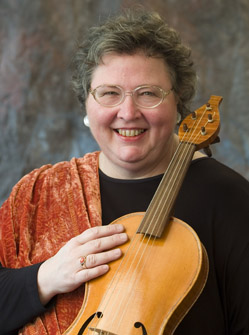 SFEMS joins the early music world in mourning the loss of one of its greatest contributors as well as our dear friend, Margriet Tindemans, who died in Seattle on December 31 of last year. A native of Holland and student of Wieland Kuijken, Margriet was equally at home playing Renaissance or baroque viola da gamba or medieval vielle. As a performer, teacher, and recording artist, she was renowned across Europe and America.
SFEMS joins the early music world in mourning the loss of one of its greatest contributors as well as our dear friend, Margriet Tindemans, who died in Seattle on December 31 of last year. A native of Holland and student of Wieland Kuijken, Margriet was equally at home playing Renaissance or baroque viola da gamba or medieval vielle. As a performer, teacher, and recording artist, she was renowned across Europe and America.
Let me say up front, I am not the right person to memorialize her, being neither a string player nor a medievalist. Others in our immediate community who knew her far better—and there are many here she inspired—undoubtedly will have more and profounder things to say. There have been several comprehensive obituaries and remembrances published on line, including these by Sequentia’s Ben Bagby, The Seattle Times, and the Medieval Women’s Choir. Rather than borrow from their tributes, which I encourage everyone to read, I will simply share three personal memories of Margriet, which offer insight into her character, intellect, and talents.
SFEMS presented Margriet on our concert series several times, and she also taught at our summer workshops. One of the concerts on the SFEMS series featured her with fellow medievalists Shira Kammen, Peter Maund, Kit Higginson, and perhaps others. I cannot recall the year of the performance nor the concert title, but the theme had something to do with medieval jongleurs, the multi-talented minstrels who gave impromptu shows, not only singing and playing a variety of instruments, but also juggling, doing magic tricks, sometimes even working with trained animals. To prove the point, the assembled company decided to include some real “jongling.” Fortunately, there were no trained bears on stage, but Margriet did a splendid job juggling three or four zucchini, keeping them all aloft for several minutes without dropping any. It was a good demonstration not just of her versatility, but of her coordination, balance, and acute sense of time, which also no doubt informed her playing.
I got a good demonstration of Margriet’s acute ear at the SFEMS Medieval and Renaissance Workshop one summer, where I was lucky enough to have her as an ensemble coach. It was a small brass group, one or two cornetts and a couple sackbuts. We were working on some relatively simple Spanish Renaissance canciones and villancicos. Margriet decided to focus on mean-tone tuning. I remember her telling us, “Robert, make your D a little higher; Jonathan lower your F,…” and so on, paying careful attention to each chord. When we played through what we had previously done, following her instructions, the music leapt into relief in an entirely new way. It felt as though I was seeing something in three dimensions and color that I only had seen before as a black & white photo—one of those “Aha!” moments that I always will cherish for the insight it gave me into music.
The final story is a conversation we had perhaps 25 years ago, at a time when I was feeling restless and thinking of moving out of the Bay Area. One of the places I had considered relocating was Seattle. I cornered Margriet during a post-concert reception at The Musical Offering and asked her, particularly, about Washington’s long, rainy winters and whether she found them depressing. Margriet just smiled and started laughing. “Look,” she said, “I am Dutch. In Holland, from November through April you do not ever see the sun. It is grey and rainy for six months. In Seattle, even on rainy days, you always have 15 minutes when the sun breaks through. You cannot imagine what a difference that makes.”
And that was Margriet: good natured and playful, capable of understanding the significance of the smallest details and showing how much they mattered, and willing to see the silver lining inside any cloud.
Thank you for your musicality, generosity, and good humor, and for the many ways you enriched our lives.
Rest in peace.
—Jonathan Harris












